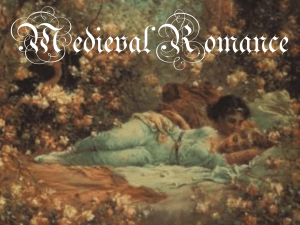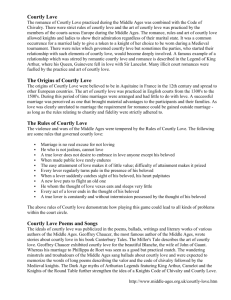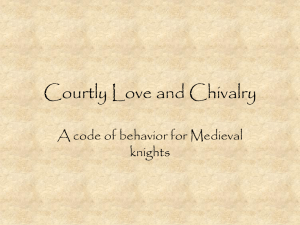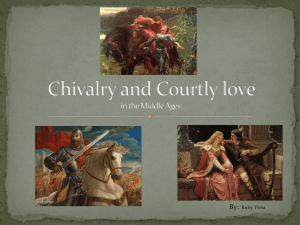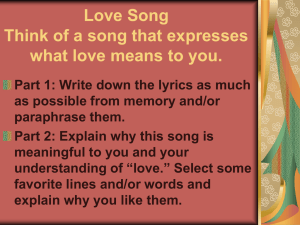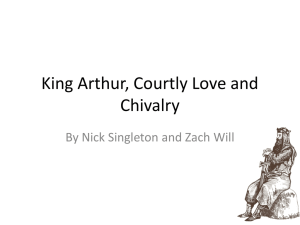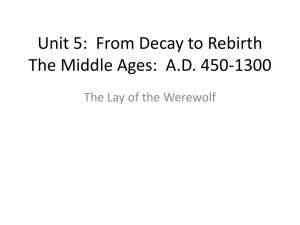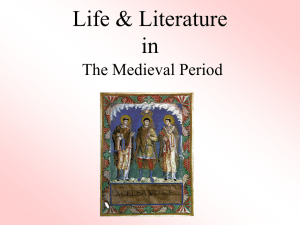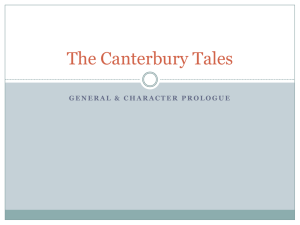Hellow
advertisement
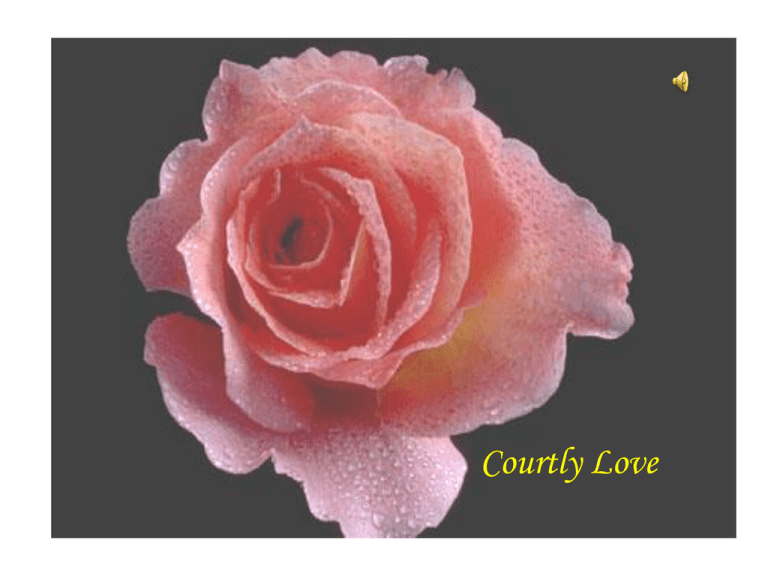
Courtly Love What is “courtly love” and where did the ideal originate? • Courtly love is an idealized notion of pure, enduring love that was popular in medieval literature. • In understanding courtly love it is advantageous to present first a conceptual theory of love itself, from the perspective of a Christian culture. • In the ancient Greek language in which most of the New Testament was written, there are three words for love: eros, agape and philia. What is “courtly love” and where did the ideal originate? • For the most part, eros, translated often as erotic love, is construed as covetous human love, or love based on give and take in a context of passion or ecstasy. • Philia, usually translated as “friendship” is the type of love that is also covetous, but without passion. • Agape is often translated as “charity” a love that is based in unconditional giving and service. What is “courtly love” and where did the ideal originate? • In the late 19th century, the philosopher Nietzsche argued that Christianity poisoned the Greek concept of eros, which was tied into sacred fertility rituals. By negating human sexual love, he argued, it was desecrated and despoiled and became unholy and unhealthy vice.* But this wasn’t always the case! • While it is simpler to keep these variations of love completely discrete, and without doubt they were taught as being discrete, philosophical theologians would argue otherwise. What is “courtly love” and where did the ideal originate? • For two humans, the joining of bodies in sexual love can be metaphorically tied to the unification of each of us to one another in our very blood and DNA.* • In the Old Testament, the Song of Songs is often viewed metaphorically as a combination of eros and agape, the lovers portrayed as those who are joining themselves in a ritualistic worship of God. • In the New Testament, Jesus introduces the ritual of Communion. Humans take part of the body and blood of the deity and become in part, divine. What is “courtly love” and where did the ideal originate? • Thus the death of the Christ becomes and ecstatic moment where humans are transformed, for the human soul achieves immortality. It is a departure from pagan sexual fertility rights and human sacrifice, in that the body of God, not human sexuality is the feast. • In his first encyclical, Deus Caritas Est, Pope Benedict XVI argues for the unification of eros and agape in the way we should view one another and God. He argues that human sexual love is also sacred, for with the commitment of marriage, love becomes eternal. What is “courtly love” and where did the ideal originate? • But how can human love be both completely pure and passionate? • How can love for God be both pure and ecstatic? • This is the conundrum of courtly love.* Ars Amatoria • While Christians in the middle ages certainly had much philosophical theology available on the various concepts of love (St. Augustine, St. Dionysius) oddly (or perhaps, simplistically) the Ars Amatoria emerges as an archetype for the main conventions of courtly love. • Written by Ovid, Ars Amatoria (The Art of Love) was basically a book on how to pick up a chick in Rome, and how to survive, or not, if she refused! • Ovid depicts a lover as a slave to passion, sighing and trembling, growing pale and sleepless, and eventually, dying, sick with love! • This work was clearly a satire, but that was apparently lost in the “purified” translation!* Medieval Versions of Love • While the goal of Ovid’s lover was sensual rewards, the edited medieval version followed a different, idealized model: The medieval lover while suffering from the same disease, was expected to “cure” his love with a form of religious (Madonna) worship. • It is interesting to note, that the celebration of the holiday of St. Valentine’s Day – formerly a Roman fertility festival – began during the middle ages. It was thought that birds found their mates on this day. St. Valentine was a Christian condemned to die. The jailor’s daughter falls in love with him and sends him notes of her undying—and functionally unrequited love. She converts, impressed by his faith. Medieval Versions of Love • In modern times, scientists have isolated certain hormones that are released during early love, which are closely related to amphetamines. These are phenylethylamine, norepinephrine and dopamine. It takes somewhere between six months and three years for these chemicals to gradually stop flooding your brain. Like drugs, they do interfere with logical thinking. Only after they have abated can you begin to consider that the relationship might be “true love.” Chocolate also releases phenylethylamine (PEA), and in fact, shortly after chocolate made its way to Europe from the New World, nuns were forbidden to eat it, likely due to its reputation as an aphrodisiac. Medieval Versions of Love • Marriage was just beginning to be a celebrated event among the lower classes, and marriage laws begin to evolve. • Contracts were drawn, especially if there was an inheritance involved. Marriages were made as political or business arrangements, but often they resulted from an unexpected pregnancy. A priestly blessing was required to join the couple when the woman was forced into the marriage. • There was no divorce, but separations were common. • Marriage as a sacred institution wasn’t made formal until the 16th century Counsel of Trent, in a counter-Reformation move, when a priest was required to bless all marriages. Conventions of Courtly Love • The lady, always a beautiful, righteous and exemplary woman, was married to a noble, or otherwise completely unattainable – far away, a sworn virgin, a nun, or even dead! • The courtly lover was reduced to pure, idealized adoration, completely chaste and faithful service and devotion, unfailing obedience, and undying, eternal, passionate love. • Failure to gain sexual relief often resulted in death. Or something like death. Conventions of Courtly Love • Many seduction poems would use this metaphorical death to make the argument that the beloved should consent to sexual intercourse. • Another motif associated with love and love sickness was the idea that it was a “hunt” and the “hunted” – often a fox or hart – was wounded and “killed” either by the lover or the lady, usually with a not-so-subtle arrow. This metaphor points do a different type of “death” and a different type of ecstasy—not exactly courtly! Conventions of Courtly Love • Medieval gardens become common settings for the allegory of courtly love. The notion of the “rose” and the “garden” were common symbols of pure womanhood, and gentile (civilized) wooing within the confines of court society. (Cultivated garden vs. wilderness) Conventions of Courtly Love • The gardener gently tends the garden, nurturing his beloved rose. (If the lady IS available, this type of wooing might move courtly love to accepted human love.) • The symbols originate with Mary and the Garden in Eden. Gardens were places of exquisite beauty, but civilized, a place of tamed passions. • Pastoral poems later on will adopt this “garden” concept as a rationale for a more open approach to natural sexuality. Courtly Love in Literature… • A hundred years earlier, Ibn Hazm (994-1064) had published his own treatise on love in Andalusian Spain: The Neck-Ring of the Dove.* It is likely another strong influence on this ideal, as it later develops in Europe. • Visions of the lady-as-saint are presented in Petrarch’s Laura and Dante’s Beatrice – also in the allegorical poem, Pearl. • Many romances also include elements of this in stories of chaste knights serving royal queens, especially in the stories involving Lancelot and Guinevere. • A debate for the courtly love conundrum is found in the allegorical poem, Le Roman de la Rose. Courtly Love in Literature… • The first half of Le Roman de la Rose, written in 1230 by Guilliaume de Lorris sweetly describes how to woo a maiden in terms of “plucking” a rose within the boundaries of the medieval garden. • The second section of the poem, added in 1280 to the unfinished original by Jean de Meun, mocks this whole weird discipline, and is a cynical satire of the purity of women, the church, society, and love itself! Courtly Love in Literature… • Through modern times, Le Roman de la Rose influenced many debates – literary and otherwise – on the nature of love. • Chaucer translated this poem from Old French into Middle English, and it serves as fuel for his “Knight’s Tale.” • As the spark of humanism fires up, the notion of courtly love fades. Pure, distant love, eternal love and adoration don’t find a place in the new reality. Courtly Love in Literature… • Shakespeare, in the more enlightened Renaissance, would create Rosalind to acknowledge that, “Men have died from time to time, and worms have eaten them, but not for love.” (As You Like It 4.1.81-92) (However, see The Winter’s Tale, and the dueling pastoral love poems of Sir Walter Raliegh and Christopher Marlowe…) • In Romeo and Juliet, this is the love Romeo has, and discards, with Rosaline, in favor of a more satisfying, though ultimately deadly, love with Juliet. • However, remnants of courtly love, mocked or otherwise, appear as de rigueur conventions in pastoral and seduction poems through the centuries. Courtly Love Codex • The radical behavior of courtly love was codified in a three-volume treatise by the 12th century writer Andre Le Chapelain (1185): “Book of the Art of Loving Nobly and the Reprobation of Dishonorable Love.” • Andre was believed to have been a chaplain in the court of Eleanor of Aquitaine, wife of Henry II (1154-1189) and both the Queen and her daughter Marie commissioned his writings.* (See Henry and Becket, Canterbury program.) • From this comes a belief that the origins of this ideal might have been castle life, where there were many young knights who were expected to serve a beautiful Queen.** …And in Life! • While the reality of castle life, and the teachings of the Church toward women and marriage, may have influenced the concept of courtly love, perhaps more importantly, the ideal provided a model by which people could bear the deaths of their beloved, for the doctrine codified eternal love that lasted beyond the grave. …And in Life! • In a time full of early death, especially of women in childbirth, the script of courtly love made a framework people could follow within the workings of the society; it was perhaps a salve for the loss of a young lover or a child, and helped to provide a context for the remaining fervor of love.
